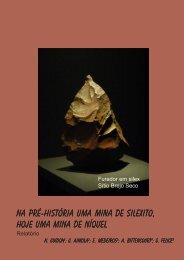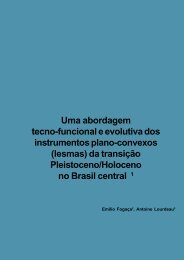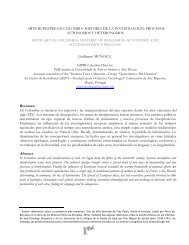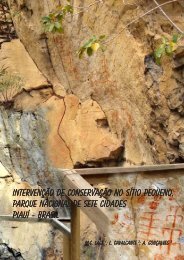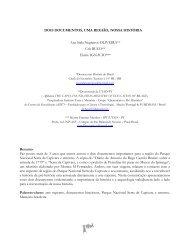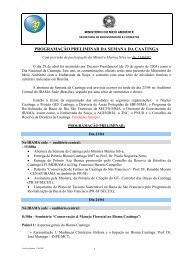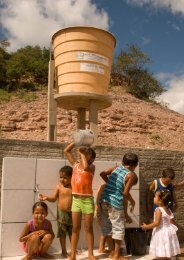Untitled - Fundação Museu do Homem Americano
Untitled - Fundação Museu do Homem Americano
Untitled - Fundação Museu do Homem Americano
Create successful ePaper yourself
Turn your PDF publications into a flip-book with our unique Google optimized e-Paper software.
Museo de Museos de Arte Rupestre: un proyecto para el estudio de la historia de las investigaciones<br />
en Arte Rupestre<br />
Guillermo Muñoz Castilblanco, Colômbia<br />
El proyecto de Museos de Museos es una vía de investigación y divulgación de la historia del arte<br />
rupestre internacional. El proceso consiste en investigar la historia de los registros y hacer un homenaje<br />
a los investiga<strong>do</strong>res. Los diversos gráficos y <strong>do</strong>cumentos son expuestos en lugares públicos y con ello<br />
se hace un museo al aire libre, en <strong>do</strong>nde la población y los visitantes pueden observar distintas zonas<br />
del mun<strong>do</strong> y diversos perío<strong>do</strong>s y técnicas de registro. Esta actividad de Museo de Museos se realiza<br />
en la población de Maçao Portugal, apoya<strong>do</strong> por la alcaldía municipal dentro del programa cultural de<br />
la comunidad europea Trans-formations. En la actualidad este proyecto se realiza en su primera etapa<br />
en la cual se han realiza<strong>do</strong> murales de Europa, Asia, Africa y América.<br />
The <strong>Museu</strong>m of Altamira, the Neo-cave (the facsimile of the cave): ten years of experience and<br />
2.500.000 of visitors<br />
José A. Lasheras , Espanha<br />
The <strong>Museu</strong>m of Altamira is a venue devoted to learning about, enjoying and experiencing the life of those<br />
who painted and inhabited the cave of Altamira. The museum’s most attractive offer is the possibility<br />
of becoming familiar with Altamira, humanity’s first art. Based on scientific rigour and at the service of<br />
all types of users, it is a centre for preservation, investigation and dissemination of the cave of Altamira<br />
and Prehistory. Since the inauguration of the new museum in 2001 more than 2.500.000 people have<br />
visited the <strong>Museu</strong>m of Altamira. The cave of Altamira, the permanent exhibition including the Neo-cave,<br />
cultural activities, prehistoric technology workshops and the surrounding environment full of woods and<br />
mea<strong>do</strong>ws, all compose the museum’s offer. Preservation of the cave and research on it complement the<br />
museum’s activity.<br />
102<br />
El conjunto de pinturas rupestres del Cerro de Guachipas, Salta, Argentina. Un patrimonio<br />
prehistórico para un Parque Eco-Museal.<br />
Marta Irene Arancio, Argentina<br />
El Cerro de Guachipas en provincia de Salta es una concentración de pinturas rupestres en aleros más<br />
o menos profun<strong>do</strong>s, descubierto a l’inicio del siglo XX por Juan Bautista Ambrosetti.<br />
Las pinturas rupestres de Guachipas fueron declaradas Monumento Histórico Nacional. El Cerro<br />
Cuevas Pintadas de Guachipas está forma<strong>do</strong> por 33 aleros, <strong>do</strong>nde los habitantes originarios plasmaron<br />
dibujos y formas abstractas. Los motivos pre<strong>do</strong>minantes son los caméli<strong>do</strong>s y los llama<strong>do</strong>s “hombres<br />
escu<strong>do</strong>s” que son figuras antropomorfas de gran variedad de formas, colores y estilos.En los paneles<br />
están representa<strong>do</strong>s escenas y personajes de la vida cotidiana de perío<strong>do</strong>s prehistóricos: ceremonias<br />
religiosas, guerreros,y animales como suris, jaguares, aves, insectos y llamas. Documentos coloniales<br />
hablan de este lugar como un sitio consagra<strong>do</strong> al sol.<br />
El Cerro de Guachipas necessita de una protection total y una puesta en valor con un Proyecto de Parque<br />
eco-museal (cultural y natural) con un enfoque al desarrollo local.<br />
When a rock engraving site becomes portable rock-art. The Brompton petroglyph site<br />
Daniel Arsenault, Éric Graillon, André Bergeron - Canadá<br />
In the Canadian Shield, there are just a very few rock engravings sites made by the to be seen by the<br />
general public, even though some are quite impressive (e.g. the Peterborough Petroglyphs site, Ontario).<br />
However there is one, called the Brompton petroglyph site and located on the St. François River (Québec),<br />
which has been mainly removed in the mid-1960s by an amateur archaeologists as a “conservation<br />
procedure”, although some engraved parts were to be left in situ. After 40 years of peregrinations, the<br />
remaining engraved pieces where to be finally put into a permanent exhibition in a Provincial museum<br />
in the town of Sherbrooke, Province of Québec. This paper will tell the story, with its various “dramatic”<br />
episodes, of that site during which its various parts were to become momentarily “portable rock art” until<br />
they were put in a museum for their final safeguarding.<br />
FUMDHAMentos IX




